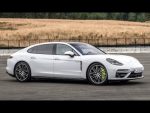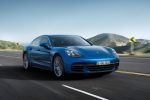Style, aggression, innovation and beauty are just some of the words used to describe Porsche. Whether you buy one, or just undertake Porsche hire for a day, this legendary automobile should be driven at least once in a supercar enthusiast’s lifetime. The timeline below reveals some of the most influential Porsche models in history – enjoy!
1950 Porsche 356 1100
Before the legendary Porsche 365 110 was introduced, each Porsche was hand-built in an old sawmill in Gmund, Austria. Each vehicle was different at the time, but when the production moved to Stuttgart 1950, the company could produce more standardised models. The 1950 model would be the first in a long and illustrious history.
1955 550 Spyder
The successor to the original 365, the 550 Spyder oozed pure racing style. In its heyday, this speedster was one powerful machine. The car boasted a more rigid frame and a lightweight aluminium body which was hand-built. The power output was just 70 horsepower, but the overall design and engineering made it a unique and ferocious package. The limited edition vehicle is best known in the US as James Dean’s last ride.
1965 911 Targa
One of the first in the defining 911 series, the Targa was a solution against threats from the National Highway Transport Safety Association to ban the sale of convertible cars in North America in the 1960′s. Stylishly combining a roll bar in the design, drivers could remove the roof between the roll bar and the windscreen, as well as fold down the back window. This provided structural safety without losing the open air driving experience.
1966 911S
The 2 Litre 911 started a legacy – the 911S sent it screaming into the future. This was the start of Porsche’s decision to produce faster variants of each model, something that has continued throughout the history of the company. The 911S (S for Super) packed 160bhp power output, and adopted two triple-choke Weber 40IDS carburettors and a new exhaust system. The combination of the later created the “wail” the 911 enthusiasts have come to love.
1986-1990 Porsche 959
Originally built to compete in Gruppe B motorsport, the Porsche 959 would become an icon as one of the most advanced and fastest cars to ever be built. Carbon-fibre panels, four-wheel drive, active suspension, tyre pressure sensors, run flat tyres and a six-speed gearbox were all present and contributed to the overall package. Stunning curvaceous lines accompanied the earth-shattering power that could rocket the car from 0-62mph in just 3.7 seconds.
2003 Carrera GT
At this time in their history, Porsche aimed to make a supercar that stood out above the rest – the Carrera GT did just that. Combining innovation and the latest technology, the car was the first to use a carbon-reinforced plastic chassis. This provided a substantial saving in weight. Along with lightweight carbon-fibre and Kevlar bodywork, the GT weighed in at just 1380kg. Add a V10 engine producing 610bhp, and you will understand why this car left competitors in its tyre smoke.
2010 Cayenne Turbo
Many enthusiasts slammed the release of this model, saying that it did not tie in with the brand’s identity. The truth is, Porsche struggled to sell cars in the late 80′s and were almost forced to close their doors permanently after the turn of the decade. The Cayenne was introduced not only to cash in on the SUV craze worldwide, but to attract new drivers to try out their other models at the same time.
2010 911 GT3 R Hybrid
Welcome to the future. The Porsche 911 GT3 Hybrid made its race debut in China in November 2010, and was by far the fastest GT vehicle in the 1000km international Le Mans cup race in Zhuhai. This 480-horsepower monster is propelled by a system consisting of two 60kW motors that rotate the front wheels and a flat-six engine the drives the rear. When breaking, the electric motors store kinetic energy in the electromechanical flywheel, which can be released automatically or on demand. This saves wear and tear, as well as adds to the overall efficiency.
Which revolutionary models would you choose?







